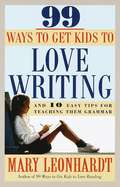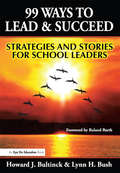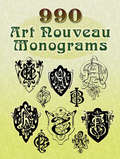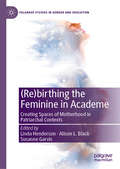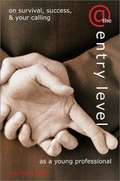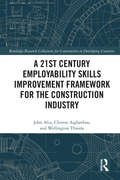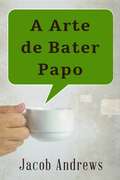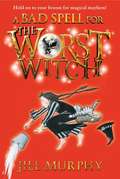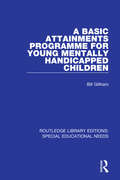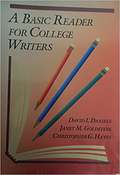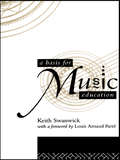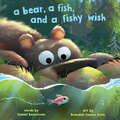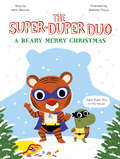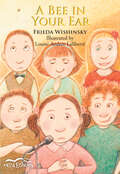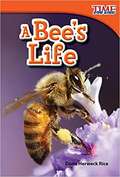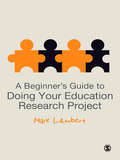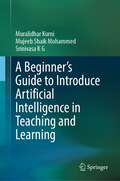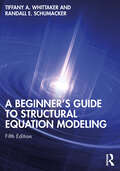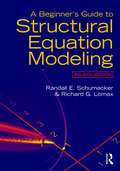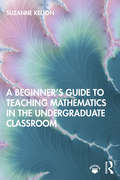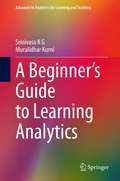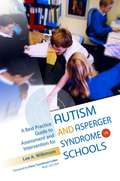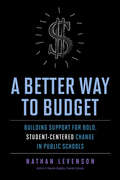- Table View
- List View
99 Ways to Get Kids to Love Writing and 10 Easy Tips for Teaching Them Grammar
by Mary LeonhardtStrong writing skills are essential for success in school, college, and on the job. In 99 Ways to Get Kids to Love Writing, educator Mary Leonhardt provides parents with practical, easy-to-follow tips on how to teach their children the fundamentals of writing and make it fun for them at the same time. Here are just a few of her nuggets of advice: ¸ Always be encouraging about your children's writing. ¸ Don't worry about teaching grammar to kids when they are just beginning to write. Most grammar knowledge is acquired rather than directly learned. ¸ Provide plenty of writing material. ¸ Encourage your preschool children to dictate stories to you. Leonhardt follows up with 10 Easy Ways to Teach Them Grammar, essential tools for all budding writers.
99 Ways to Lead & Succeed: Strategies and Stories for School Leaders
by Lynn Bush Howard BultinckVeteran educators Howard J. Bultinck and Lynn H. Bush draw from their own experiences as principals and teachers to offer school leaders 99 lessons they've learned on the job and in daily life. With this book, principals, other administrators, and teacher leaders have a surefire head start on effective school leadership. 99 Ways to Lead and Succeed: Strategies and Stories for School Leaders provides workable insights on the daily life of a school leader, including ways to handle stress, communication tips, moral and ethnical approaches, and more. This handy guide is for all teacher leaders, principals, and administrators who seek to noticeably improve their personal and professional lives in the context of school leadership.
990 Art Nouveau Monograms (Dover Pictorial Archive)
by DoverThis singular collection displays pairs of letters, transforming ornamental initials into Art Nouveau masterpieces. Undulating lines, sensuous curves, writhing vines, and tendrils of leafy flora decorate every two-character combination, from A to Z. Featuring 990 imaginative illustrations, this treasury is perfect for tracing and copying. The marvelous monograms will also be enjoyed for their fine aesthetic beauty, and are sure to provide a wealth of inspiration for art projects of any kind.
: Creating Spaces of Motherhood in Patriarchal Contexts (Palgrave Studies in Gender and Education)
by Susanne Garvis Alison L. Black Linda HendersonThis book engages expansively with the concept of motherhood in academia, to offer insights into re-imagining a more responsive higher education. Written collaboratively as international, interdisciplinary and intergenerational collectives, the editors and contributors use various ways of understanding ‘motherhood’ to draw attention to – and disrupt – the masculine structures currently defining women’s lives and work in the academy. Shifting the focus from patriarchal understandings of academe, the narratives embrace and champion feminist and feminine scholarship. The book invites the reader to question what can be conceived when motherhood is imagined more expansively, through lenses traditionally silenced or made invisible. This pioneering volume will be of interest and value to feminist scholars, as well as those interested in disrupting patriarchal academic structures.
@ The Entry Level: On Survival, Success, & Your Calling As A Young Professional
by Michael BallCash, Coercion, Cons, Whatever it takes to get unsuspecting grads to sign that offer letter, Corporate America is game. Because once it's finally plain that the entry level, in fact, is a hellish and demeaning place of grunt-work, brown-nosing, and mental drool, the ink's already dry and the newbies in bed. Way in, what with the pressure to keep post-college resumes stocked with "respectable" Fortune 500 firms. Instead, most early-stage workers end burying their dreams underneath their paycheck, suffering quietly through the frustration, depression, and thoughts of beating their manager with a stick. No more. @ The Entry Level is designed to lead you through the psychologies, philosophies, and strategies for succeeding in business' basement, but with the single-minded purpose of finding the work you were made to do. It's the first book ever to dispel the myths, whisper the tricks, and supply the tools to help you as a young professional: *Manage the transition from college to work *Negotiate the Entry Level Rite of Passage Navigate office politics and build your personal brand *Earn the promotion or transfer with the right fit *Locate a sturdy work - life balance *Uncover your values to make intelligent, healthy career decisions *Gain the courage to follow your passion and find your calling Further taking a hard look at the seduction of money, the silliness of company loyalty, and the side-effects of waiting until midlife to figure out what your job should mean, this is the indispensable guide for career freshmen seeking a deeper, richer working life. And for those who just need to keep breathing. Michael Ball is the founder and CEO of Career Freshman Company, an organization dedicated to helping young professionals discover success, passion, and fulfillment in their work. A disillusioned Big Five (now Four) consulting veteran and Silicon Valley startup survivor, he's found his own calling as an author, speaker, and career coach to college students and corporate grunts. He lives in Los Angeles.
A & P Technician Powerplant Textbook
by JeppesenThe lack of efficient and practical powerplants has limited aircraft development throughout history. For example, in 1483 Leonardo daVinci conceived a flying machine he called the aerial screw. However, without a powerplant, the aerial screw was never developed.
A 21st Century Employability Skills Improvement Framework for the Construction Industry (Routledge Research Collections for Construction in Developing Countries)
by Clinton Aigbavboa Wellington Thwala John AliuThis book will provide readers with an understanding of the employability concept and develop an employability skills improvement model to enhance the employability of built environment graduates to foster economic development. The developed model determines the influence of generic skills, discipline specific skills, work-integrated learning, emotional intelligence, university-industry collaboration outcomes and 4IR knowledge in predicting the outcomes of improved graduate employability. The model is developed with a theoretical lens on existing frameworks of employability and skills development. Whilst drawing comparisons with countries such as the UK, USA, Australia and Canada, the authors present the results of a two-stage Delphi survey in South Africa as a case study on the current state of skills development and on the skills of the future. The case study is presented in line with the South Africa’s long-term National Development Plan (NDP) aimed at developing the key capabilities and skills of its citizens by ensuring quality education on a broader scale by 2030. As automation continues to rapidly advance, the pressures on universities to revamp and restructure their curricula have become increasingly necessary. This book recommends that higher education institutions urgently need to intensify their efforts by introducing significant modifications to the science and technology curriculum to enable students to develop and acquire competencies in the rapidly emerging areas of artificial intelligence, data science, robotics, advanced simulation, data communication, system automation, real-time inventory operations, cloud computing, and information technologies. This implies that universities’ curriculum should be infused with 4IR thinking within the conventional primary sciences of biology, chemistry, and physics, with greater emphasis on digital literacy to boost 4IR understanding amongst the graduates. The book is therefore of interest to researchers and policy makers in the built environment that are placed in academia, the construction industry or at consultancy levels, it provides significant recommendations for universities as they intensify their efforts to develop graduates for the future.
A 3D Visualization Teaching-Learning Trajectory for Elementary Grades Children (SpringerBriefs in Education)
by Jacqueline Sack Irma VazquezThis monograph describes the development and use of a 3D visualization teaching-learning trajectory for elementary age learners. Using design research principles, the authors developed this trajectory using the NCTM recommendations and the Spatial Operational Capacity (SOC) theoretical framework to guide lesson development. The SOC framework utilizes actual 3D models, 2D and abstract representations of the actual models, and, a dynamic computer interface, the Geocadabra Construction Box, which integrates these representations dynamically in real time. The work begins with describing the theoretical SOC frameworks that guided the study, the inquiry-based learning focus, the research method used, and informal pre-program interviews with participant children. The next chapter describes introductory activities used to orient the children to the 3D objects that they used throughout the program. The book then focuses on the development of abstract top-view numeric plan representations leading to representations of rectangular prisms, followed by front-side-top view representations. The last chapter shows how numeracy was integrated into the program to support the demanding official mathematics curriculum.
A Arte De Bater Papo: Construindo Relacionamentos De Sucesso
by Jacob Andrews Mayara LealVocê tem medo de iniciar uma conversa? Já quis falar com alguém, mas não sabia o que dizer? Já se sentiu estranho na hora de conhecer alguém? Acha que bater papo é uma perda de tempo?Então este livro é para você!Em A arte de bater papo, você vai aprender o seguinte: *Como tornar-se um conversador eficaz *Como causar uma boa primeira impressão *Como criar rapport usando habilidades conversacionais *A importância da comunicação não verbal e como tirar proveito dela *Como lidar com a ansiedade social *Táticas para superar o medo de falar com pessoas e grupos *Como criar uma conexão com outra pessoa *Como usar quebra-gelos para iniciar uma conversa *Como manter a conversa e fazer a outra pessoa falar *Como terminar uma conversa *Como conversar com confiança *Como nunca ficar sem saber o que dizer novamenteSer bom de papo é uma habilidade poderosa. Ela será valiosa quando você estiver em uma entrevista de emprego, numa festa, ou quando quiser se aproximar de um possível parceiro romântico.
A Bad Spell for the Worst Witch (Worst Witch #3)
by Jill MurphyMildred gets off to a good start in her second year at Miss Cackle’s Academy, but her sworn enemy, Ethel Hallow, is plotting misfortune, setting Mildred up for a very bad spell, indeed. [From the back cover:] "A new term spells disaster for Mildred! Mildred is determined to lose her embarrassing reputation as the worst witch Miss Cackle's Academy has ever seen, but things rapidly get out of hand!" It isn't easy to stay out of trouble when Mildred's arch enemy Ethel promises to make Mildred pay for scaring her little sister. When a spell turns Mildred into an animal she must run for her life. Then she finds another animal who was once human. It going to be risky for Mildred to save herself and her new friend but Mildred's no quitter! Ages 8-12 Pictures are described. Read all seven magical adventures in this series about a witch school for girls in the Bookshare Library. #1. The Worst Witch, #2. The Worst Witch Strikes Again, #4. The Worst Witch at Sea, #5. The Worst Witch Saves the Day, #6. The Worst Witch to the Rescue and #7 The Worst Witch and the Wishing Star.
A Basic Attainments Programme for Young Mentally Handicapped Children (Routledge Library Editions: Special Educational Needs #26)
by Bill GillhamFirst published in 1987. Most non-handicapped children entering school are prepared for the school curriculum in that they have acquired, incidentally, a range of skills that are needed for school-type attainments (reading, numbers, etc.). However, by definition mentally handicapped children make slower progress and do not learn so easily in this indirect fashion. This book is a manual presenting a programme which sets specific objectives and methods by which mentally handicapped children can be taught the basic prerequisites of school success. Implicit in this intention is the assumption that many such children can and should be admitted to ordinary schools. A linked assumption is that parents and non-specialist teachers will therefore need practical guidance in this area. The book will also be of value to teachers in special schools for the handicapped because it focuses on the difficult-to-teach basic prerequisites of school attainments. Each chapter contains: ‘ceiling’ objectives; an outline summary of step-by-step objectives; an assessment-for-teaching checklist; background teaching activities; general teaching rules; and specific teaching procedures for each stage.
A Basic Reader for College Writers
by Janet M. Goldstein Christopher G. Hayes David I. DanielsAlthough this is designed to be a textbook, many readers will enjoy the essays, which are written by a range of authors that includes Jane Brody, John Kellmayer, Ben Fong-Torres, and Mary E. Mebane. The topics of these thirty-two essays cover throwing away food, overcoming alcoholism, learning from Japanese prisons, and baseball.
A Basis for Music Education
by Keith SwanwickFirst Published in 1979. Routledge is an imprint of Taylor & Francis, an informa company.
A Bear, a Fish, and a Fishy Wish
by Daniel BernstromFrom the creators of A Bear, a Bee, and a Honey Tree comes another fun-to-read romp featuring lovable, hungry Bear. This time, he&’s after a determined fish, who has an altogether different plan!Readers of the beloved A Bear, a Bee, and a Honey Tree met a bear who longed for honey, but never got to eat any. In this boisterous follow-up, will Bear&’s luck change? He&’s spotted a fish! And his wish? To gobble up this delicious fish dish, of course! Sadly for Bear, this is no ordinary fish—he&’s a homesick fellow determined to get back upstream where he belongs. Once again, Daniel Bernstrom and Brandon James Scott show off their deep understanding of what makes kids laugh. The longing, the chase, the action, and splash—and the delightfully tongue twisting text—will have kids asking to hear this story again and again. With just a few words and page after page of fantastic expressions, A Bear, a Fish, and a Fishy Wish has the madcap energy and playfulness that keeps kids riveted—as they learn to read!
A Beary Merry Christmas (The Super-Duper Duo)
by Henri Meunier Nathalie ChouxRory and Sheldon are just regular guys, going to school, having playdates, and, of course, counting down the days until Christmas. But when a furious bear starts wreaking havok in their calm wood, Rory and Sheldon are there to save the holiday as...the Super-Duper Duo! They use their super-duper powers—and their knowledge about animal hibernation—to calm the crazed carnivore and keep the peace. The Super-Duper Duo books mix zany adventure comics and animal facts in exciting young readers that are both hysterical and informative. Just another mission accomplished for the Super-Duper Duo!
A Bee in Your Ear (Orca Echoes)
by Frieda WishinskyKate is determined to win her spelling club's spelling bee, but the competition is fierce. She can almost put up with Violet's relentless claims of superior spelling ability, but when Kate and Jake begin to fight with each other, Kate is miserable. She wants to win the contest, but she doesn't want to lose her best friend.
A Bees' Life (Time For Kids®: Informational Text)
by Dona Herweck RiceHow does a small egg become a buzzing bee? With a graph of a bee's life cycle, vivid photos, explanatory vocabulary, and informational text, readers are sure to be captivated! About Shell Education Rachelle Cracchiolo started the company with a friend and fellow teacher. Both were eager to share their ideas and passion for education with other classroom leaders. What began as a hobby, selling lesson plans to local stores, became a part-time job after a full day of teaching, and eventually blossomed into Teacher Created Materials. The story continued in 2004 with the launch of Shell Education and the introduction of professional resources and classroom application books designed to support Teacher Created Materials curriculum resources. Today, Teacher Created Materials and Shell Education are two of the most recognized names in educational publishing around the world.
A Beginner's Guide to Doing Your Education Research Project
by Mr Mike Lambert'Mike Lambert's book is a useful source of information, helping to create and shape your research methods project. The book contains detailed chapters with easy to follow guidelines, tips and suggestions ensuring help at every step of the way from start to finish'Alexander Miesen, student, Amsterdam University of Applied Sciences In this basic guide, step-by-step advice is presented in a clear way and chapters take the reader through the entire process, from planning and doing research, to writing it up. Each stage is covered, with detailed help on choosing a topic, drawing up research questions, doing the literature review, choosing and designing research methods, the ethics of doing research, analyzing data, and collating and presenting findings. Features in the text include: - explanations of key research terms - activities (with answers) - progress sheets - case studies Online resources to accompany the book are available at www.methodspace.com/groups/mikelambert This is an ideal text for undergraduate students undertaking their first ever research project, postgraduates pursuing Masters awards and teachers carrying out action research.
A Beginner's Guide to Introduce Artificial Intelligence in Teaching and Learning
by Srinivasa K G Muralidhar Kurni Mujeeb Shaik MohammedThis book reimagines education in today’s Artificial Intelligence (AI) world and the Fourth Industrial Revolution. Artificial intelligence will drastically affect every industry and sector, and education is no exception. This book aims at how AI may impact the teaching and learning process in education. This book is designed to demystify AI for teachers and learners. This book will help improve education and support institutions in the phenomena of the emergence of AI in teaching and learning. This book presents a comprehensive study of how AI improves teaching and learning, from AI-based learning platforms to AI-assisted proctored examinations. This book provides educators, learners, and administrators on how AI makes sense in their everyday practice. Describing the application of AI in ten key aspects, this comprehensive volume prepares educational leaders, designers, researchers, and policymakers to effectively rethink the teaching and learning process and environments that students need to thrive. The readers of this book never fall behind the fast pace and promising innovations of today’s most advanced learning technology.
A Beginner's Guide to Structural Equation Modeling
by Tiffany A. Whittaker Randall E. SchumackerA Beginner’s Guide to Structural Equation Modeling, fifth edition, has been redesigned with consideration of a true beginner in structural equation modeling (SEM) in mind. The book covers introductory through intermediate topics in SEM in more detail than in any previous edition. All of the chapters that introduce models in SEM have been expanded to include easy-to-follow, step-by-step guidelines that readers can use when conducting their own SEM analyses. These chapters also include examples of tables to include in results sections that readers may use as templates when writing up the findings from their SEM analyses. The models that are illustrated in the text will allow SEM beginners to conduct, interpret, and write up analyses for observed variable path models to full structural models, up to testing higher order models as well as multiple group modeling techniques. Updated information about methodological research in relevant areas will help students and researchers be more informed readers of SEM research. The checklist of SEM considerations when conducting and reporting SEM analyses is a collective set of requirements that will help improve the rigor of SEM analyses. This book is intended for true beginners in SEM and is designed for introductory graduate courses in SEM taught in psychology, education, business, and the social and healthcare sciences. This book also appeals to researchers and faculty in various disciplines. Prerequisites include correlation and regression methods.
A Beginner's Guide to Structural Equation Modeling: Fourth Edition
by Richard G. Lomax Randall E. SchumackerNoted for its crystal clear explanations, this book is considered the most comprehensive introductory text to structural equation modeling (SEM). Noted for its thorough review of basic concepts and a wide variety of models, this book better prepares readers to apply SEM to a variety of research questions. Programming details and the use of algebra are kept to a minimum to help readers easily grasp the concepts so they can conduct their own analysis and critique related research. Featuring a greater emphasis on statistical power and model validation than other texts, each chapter features key concepts, examples from various disciplines, tables and figures, a summary, and exercises. Highlights of the extensively revised 4th edition include: -Uses different SEM software (not just Lisrel) including Amos, EQS, LISREL, Mplus, and R to demonstrate applications. -Detailed introduction to the statistical methods related to SEM including correlation, regression, and factor analysis to maximize understanding (Chs. 1 - 6). -The 5 step approach to modeling data (specification, identification, estimation, testing, and modification) is now covered in more detail and prior to the modeling chapters to provide a more coherent view of how to create models and interpret results (ch. 7). -More discussion of hypothesis testing, power, sampling, effect sizes, and model fit, critical topics for beginning modelers (ch. 7). - Each model chapter now focuses on one technique to enhance understanding by providing more description, assumptions, and interpretation of results, and an exercise related to analysis and output (Chs. 8 -15). -The use of SPSS AMOS diagrams to describe the theoretical models. -The key features of each of the software packages (Ch. 1). -Guidelines for reporting SEM research (Ch. 16). -www.routledge.com/9781138811935 which provides access to data sets that can be used with any program, links to other SEM examples, related readings, and journal articles, and more. Reorganized, the new edition begins with a more detailed introduction to SEM including the various software packages available, followed by chapters on data entry and editing, and correlation which is critical to understanding how missing data, non-normality, measurement, and restriction of range in scores affects SEM analysis. Multiple regression, path, and factor models are then reviewed and exploratory and confirmatory factor analysis is introduced. These chapters demonstrate how observed variables share variance in defining a latent variables and introduce how measurement error can be removed from observed variables. Chapter 7 details the 5 SEM modeling steps including model specification, identification, estimation, testing, and modification along with a discussion of hypothesis testing and the related issues of power, and sample and effect sizes.Chapters 8 to 15 provide comprehensive introductions to different SEM models including Multiple Group, Second-Order CFA, Dynamic Factor, Multiple-Indicator Multiple-Cause, Mixed Variable and Mixture, Multi-Level, Latent Growth, and SEM Interaction Models. Each of the 5 SEM modeling steps is explained for each model along with an application. Chapter exercises provide practice with and enhance understanding of the analysis of each model. The book concludes with a review of SEM guidelines for reporting research. Designed for introductory graduate courses in structural equation modeling, factor analysis, advanced, multivariate, or applied statistics, quantitative techniques, or statistics II taught in psychology, education, business, and the social and healthcare sciences, this practical book also appeals to researchers in these disciplines. Prerequisites include an introduction to intermediate statistics that covers correlation and regression principles.
A Beginner's Guide to Teaching Mathematics in the Undergraduate Classroom
by Suzanne KeltonThis practical, engaging book explores the fundamentals of pedagogy and the unique challenges of teaching undergraduate mathematics not commonly addressed in most education literature. Professor and mathematician, Suzanne Kelton offers a straightforward framework for new faculty and graduate students to establish their individual preferences for course policy and content exposition, while alerting them to potential pitfalls. The book discusses the running of day-to-day class meetings and offers specific strategies to improve learning and retention, as well as concrete examples and effective tools for class discussion that draw from a variety of commonly taught undergraduate mathematics courses. Kelton also offers readers a structured approach to evaluating and honing their own teaching skills, as well as utilizing peer and student evaluations. Offering an engaging and clearly written approach designed specifically for mathematicians, A Beginner’s Guide to Teaching Mathematics in the Undergraduate Classroom offers an artful introduction to teaching undergraduate mathematics in universities and community colleges. This text will be useful for new instructors, faculty, and graduate teaching assistants alike.
A Beginner’s Guide to Learning Analytics (Advances in Analytics for Learning and Teaching)
by Srinivasa K G Muralidhar KurniThis book A Beginner’s Guide to Learning Analytics is designed to meet modern educational trends’ needs. It is addressed to readers who have no prior knowledge of learning analytics and functions as an introductory text to learning analytics for those who want to do more with evaluation/assessment in their organizations. The book is useful to all who need to evaluate their learning and teaching strategies. It aims to bring greater efficiency and deeper engagement to individual students, learning communities, and educators.Covered here are the key concepts linked to learning analytics for researchers and practitioners interested in learning analytics. This book helps those who want to apply analytics to learning and development programs and helps educational institutions to identify learners who require support and provide a more personalized learning experience. Like chapters show diverse uses of learning analytics to enhance student and faculty performance. It presents a coherent framework for the effective translation of learning analytics research for educational practice to its practical application in different educational domains. This book provides educators and researchers with the tools and frameworks to effectively make sense of and use data and analytics in their everyday practice. This book will be a valuable addition to researchers’ bookshelves.
A Best Practice Guide to Assessment and Intervention for Autism and Asperger Syndrome in Schools
by Lee A. Wilkinson*Winner in the Education/Academic category of the 2011 Next Generation Indie Book Awards**Shortlisted for the 2011 NASEN Award 'The Special Needs Academic Book'*With a focus on best practice and the importance of early diagnosis, this book provides a practical and scientifically-based approach to the assessment and diagnosis of Asperger Syndrome and autism spectrum conditions. This book offers a balance of conceptual, practical and empirical information designed to bridge the research-to-practice gap in identifying, assessing, and treating school-aged children with autism-related conditions. Assessment tools and intervention strategies will support school-based professionals in:· identifying and assessing young people with high-functioning autism spectrum conditions· developing and implementing classroom-based intervention programs· initiating a dialogue between parents and teachers· accessing community resources· promoting special needs advocacy. With illustrative case studies, FAQs, quick reference boxes, and a glossary, this accessible guide will appeal to teachers, counsellors, psychologists, social work practitioners and students.
A Better Way to Budget: Building Support for Bold, Student-Centered Change in Public Schools
by Nathan LevensonA Better Way to Budget provides practical, innovative advice on how to overcome the political and social pushback that often prevents district and school leaders from shifting scarce resources to the most student-centered uses. Nathan Levenson shows how school leaders can uncover the sources of potential conflicts and create a budgeting process that normalizes change, minimizes pushback, and builds public buy-in for needed reforms.A Better Way to Budget:focuses on a strategic and process-oriented approach that anticipates roadblocks and challenges;introduces eight effective strategies for shifting funds and winning support;provides real-life examples of mistakes and successes; andincludes joint fact-finding, simulations, and other exercises to help stakeholders agree on goals and identify the budgetary changes needed to reach those objectives.Filled with advice gathered over decades of work in schools, A Better Way to Budget provides timely insights and tools for leaders who are exploring ways to make their districts more inclusive and student-centered.
